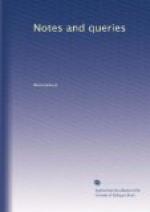“Those pardoned men
who taste their prince’s loves, (As married to
new life) do give you gloves.”]
Mr. Editor,—“Anciently it was prohibited the Judges to wear gloves on the bench; and at present in the stables of most princes it is not safe going in without pulling off the gloves.”—Chambers’ Cyclopaedia, A.D. MDCCXLI.
Was the presentation of the gloves a sign that the Judge was not required to sit upon the Bench—their colour significant that there would be no occasion for capital punishment? Embroidered gloves were introduced about the year 1580 into England.
Or were gloves proscribed as the remembrances of the gauntlet cast down as a challenge? “This is the form of a trial by battle; a trial which the tenant or defendant in a writ of right has it in his election at this day to demand, and which was the only decision of such writ of right after the Conquest, till Henry II, by consent of Parliament, introduced the Grand Assise, a peculiar species of trial by jury.”—Blackstone, Commentaries, vol. iii. p. 340. Perhaps after all it was only an allusion to the white hand of Justice, as seems probably from the expression Maiden-Assize.
Yours, &c. M.W.
Nov. 17. 1849.
P.S. Perhaps the “Lady-bird” in Suffolk derives its episcopal title, alluded to by LEGOUR, from appearing in June, in which month falls the Festival of St. Barnabas.
* * * * *
ADVERSARIA.
Don Quixote.
Sir,—Have the following contradictions in Cervantes’ account of Sancho’s ass “Dapple” ever been noticed or accounted for?
In Don Quixote, Part. I. chap. 23, we find Dapple’s abduction at night by Gines de Passamonte; only a few lines afterwards, lo! Sancho is seated on her back, sideways, like a woman, eating his breakfast. In spite of which, chap. 25. proves that she is still missing. Sancho tacitly admits the fact, by invoking “blessings on the head of the man who had saved him the trouble of unharnessing her.” Chap. 30. contains her rescue from Passamonte.
MELANION.
Doctor Dove, of Doncaster.
The names of “Doctor Dove, of Doncaster,” and his steed “Nobbs,” must be familiar to all the admirers, in another word, to all the readers, of Southey’s Doctor.
Many years ago there was published at Canterbury a periodical work called The Kentish Register. In the No. for September, 1793, there is a ludicrous letter, signed “Agricola,” addressed to Sir John Sinclair, then President of the Royal Agricultural Society; and in that letter there is frequent mention made of “Doctor Dobbs, of Doncaster, and his horse Nobbs.” This coincidence appears to be too remarkable to have been merely accidental; and it seems probably that, in the course of his multifarious reading, Southey had met with the work in question, had been struck with the comical absurdity of these names, and had unconsciously retained them in his memory.




